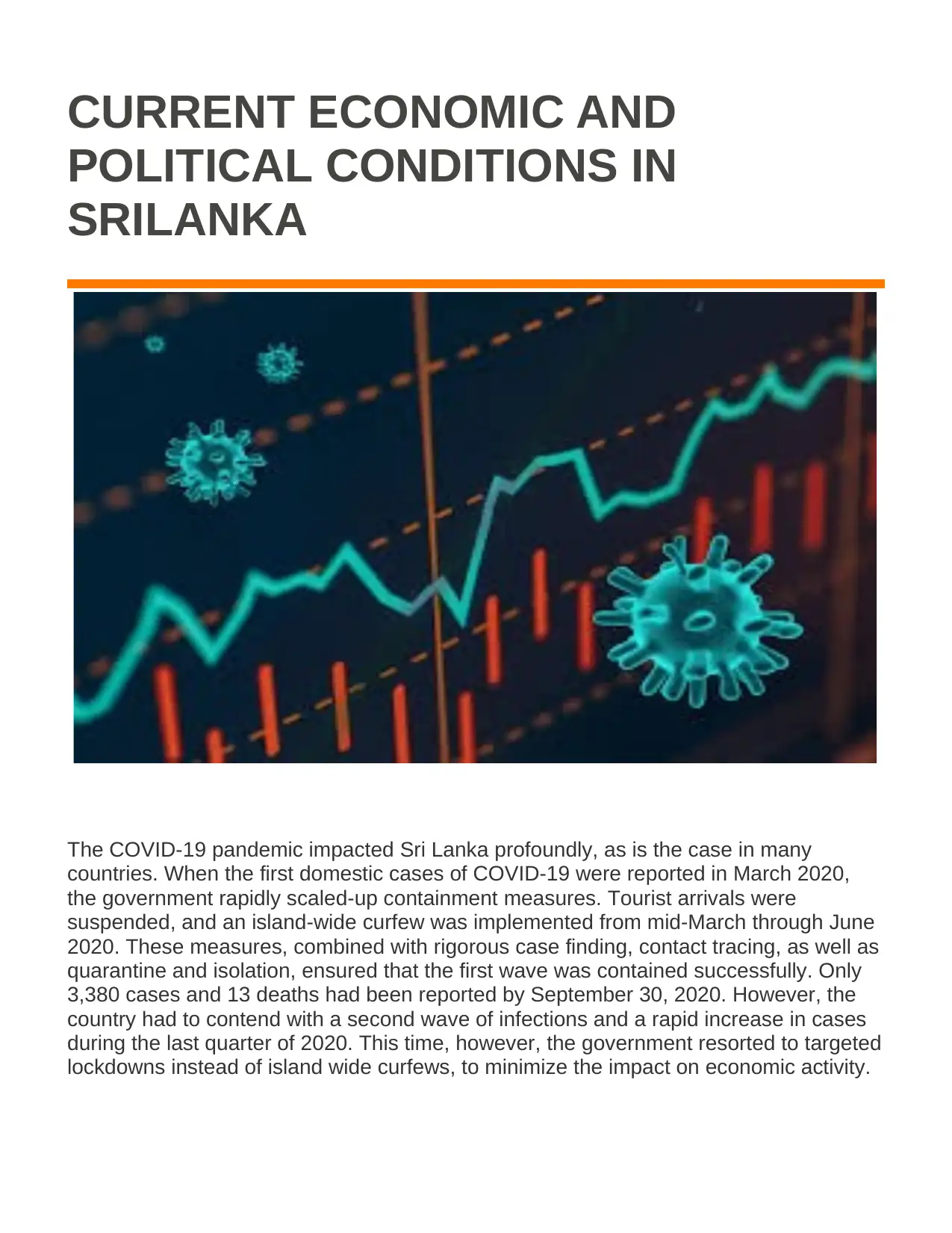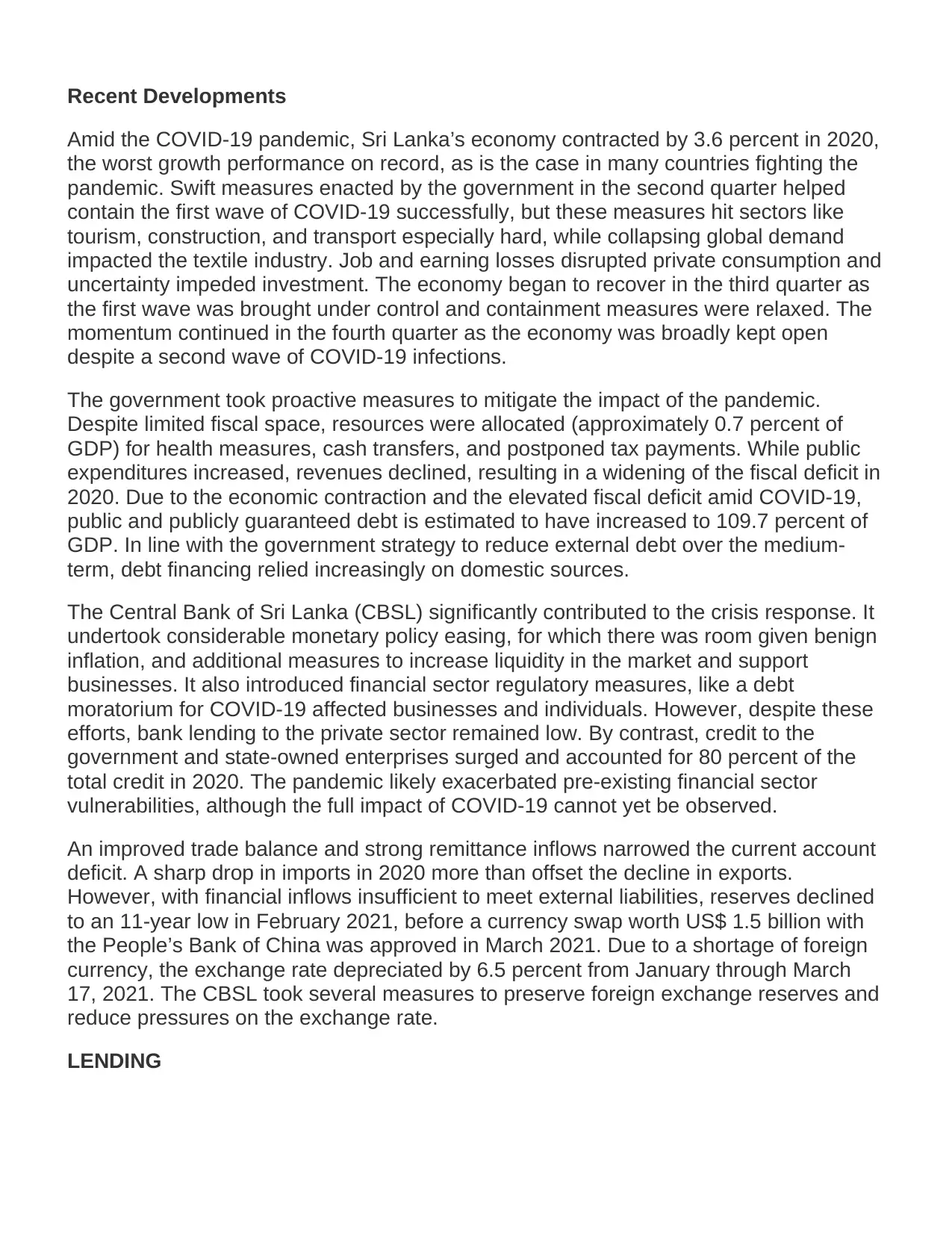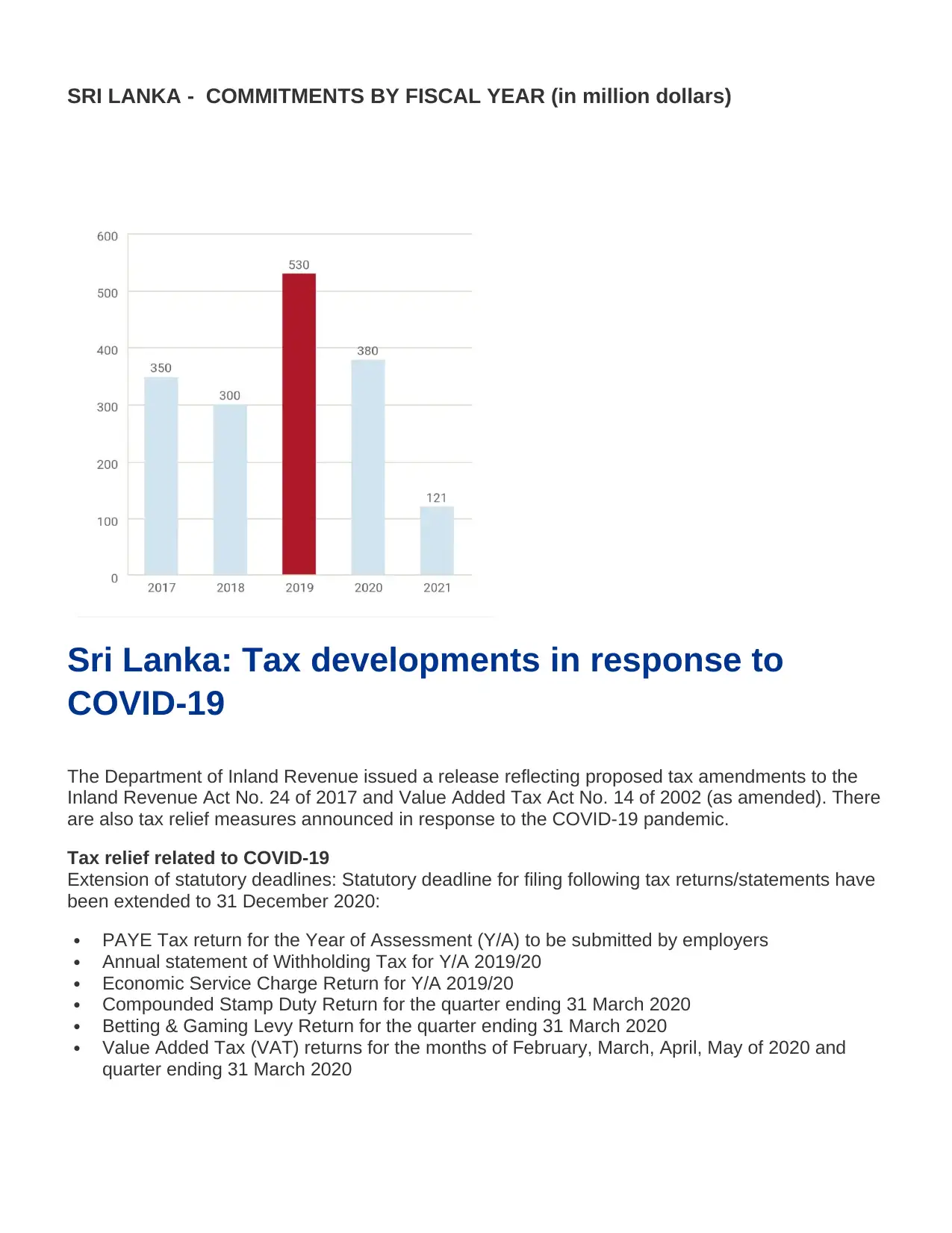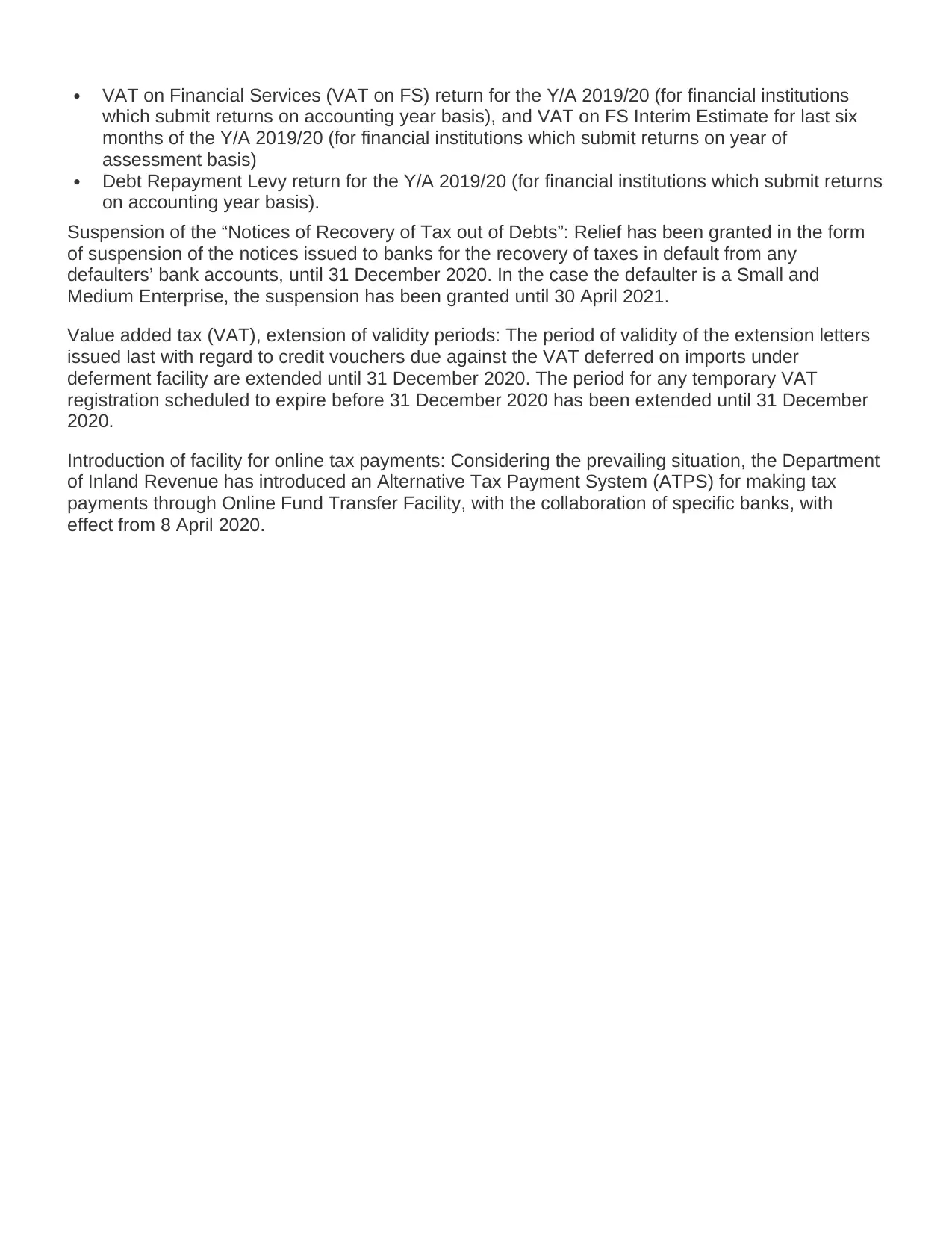Comprehensive Report: Sri Lanka's Economic and Political Landscape
VerifiedAdded on 2021/08/11
|4
|1079
|426
Report
AI Summary
This report provides a comprehensive analysis of the economic and political conditions in Sri Lanka, particularly focusing on the impact of the COVID-19 pandemic. It details the government's response, including containment measures, fiscal policies, and tax relief initiatives. The report highlights the economic contraction in 2020, the widening fiscal deficit, and the increase in public debt. It also examines the role of the Central Bank of Sri Lanka (CBSL) in mitigating the crisis through monetary policy easing and financial sector regulatory measures. Furthermore, the report discusses the impact on various sectors, trade balance, and foreign exchange reserves. It also covers the tax developments and amendments in response to the pandemic, including extensions of deadlines, suspension of tax recovery notices, and the introduction of online tax payment facilities. The report concludes with an overview of the current economic challenges and the measures taken to address them.

CURRENT ECONOMIC AND
POLITICAL CONDITIONS IN
SRILANKA
The COVID-19 pandemic impacted Sri Lanka profoundly, as is the case in many
countries. When the first domestic cases of COVID-19 were reported in March 2020,
the government rapidly scaled-up containment measures. Tourist arrivals were
suspended, and an island-wide curfew was implemented from mid-March through June
2020. These measures, combined with rigorous case finding, contact tracing, as well as
quarantine and isolation, ensured that the first wave was contained successfully. Only
3,380 cases and 13 deaths had been reported by September 30, 2020. However, the
country had to contend with a second wave of infections and a rapid increase in cases
during the last quarter of 2020. This time, however, the government resorted to targeted
lockdowns instead of island wide curfews, to minimize the impact on economic activity.
POLITICAL CONDITIONS IN
SRILANKA
The COVID-19 pandemic impacted Sri Lanka profoundly, as is the case in many
countries. When the first domestic cases of COVID-19 were reported in March 2020,
the government rapidly scaled-up containment measures. Tourist arrivals were
suspended, and an island-wide curfew was implemented from mid-March through June
2020. These measures, combined with rigorous case finding, contact tracing, as well as
quarantine and isolation, ensured that the first wave was contained successfully. Only
3,380 cases and 13 deaths had been reported by September 30, 2020. However, the
country had to contend with a second wave of infections and a rapid increase in cases
during the last quarter of 2020. This time, however, the government resorted to targeted
lockdowns instead of island wide curfews, to minimize the impact on economic activity.
Paraphrase This Document
Need a fresh take? Get an instant paraphrase of this document with our AI Paraphraser

Recent Developments
Amid the COVID-19 pandemic, Sri Lanka’s economy contracted by 3.6 percent in 2020,
the worst growth performance on record, as is the case in many countries fighting the
pandemic. Swift measures enacted by the government in the second quarter helped
contain the first wave of COVID-19 successfully, but these measures hit sectors like
tourism, construction, and transport especially hard, while collapsing global demand
impacted the textile industry. Job and earning losses disrupted private consumption and
uncertainty impeded investment. The economy began to recover in the third quarter as
the first wave was brought under control and containment measures were relaxed. The
momentum continued in the fourth quarter as the economy was broadly kept open
despite a second wave of COVID-19 infections.
The government took proactive measures to mitigate the impact of the pandemic.
Despite limited fiscal space, resources were allocated (approximately 0.7 percent of
GDP) for health measures, cash transfers, and postponed tax payments. While public
expenditures increased, revenues declined, resulting in a widening of the fiscal deficit in
2020. Due to the economic contraction and the elevated fiscal deficit amid COVID-19,
public and publicly guaranteed debt is estimated to have increased to 109.7 percent of
GDP. In line with the government strategy to reduce external debt over the medium-
term, debt financing relied increasingly on domestic sources.
The Central Bank of Sri Lanka (CBSL) significantly contributed to the crisis response. It
undertook considerable monetary policy easing, for which there was room given benign
inflation, and additional measures to increase liquidity in the market and support
businesses. It also introduced financial sector regulatory measures, like a debt
moratorium for COVID-19 affected businesses and individuals. However, despite these
efforts, bank lending to the private sector remained low. By contrast, credit to the
government and state-owned enterprises surged and accounted for 80 percent of the
total credit in 2020. The pandemic likely exacerbated pre-existing financial sector
vulnerabilities, although the full impact of COVID-19 cannot yet be observed.
An improved trade balance and strong remittance inflows narrowed the current account
deficit. A sharp drop in imports in 2020 more than offset the decline in exports.
However, with financial inflows insufficient to meet external liabilities, reserves declined
to an 11-year low in February 2021, before a currency swap worth US$ 1.5 billion with
the People’s Bank of China was approved in March 2021. Due to a shortage of foreign
currency, the exchange rate depreciated by 6.5 percent from January through March
17, 2021. The CBSL took several measures to preserve foreign exchange reserves and
reduce pressures on the exchange rate.
LENDING
Amid the COVID-19 pandemic, Sri Lanka’s economy contracted by 3.6 percent in 2020,
the worst growth performance on record, as is the case in many countries fighting the
pandemic. Swift measures enacted by the government in the second quarter helped
contain the first wave of COVID-19 successfully, but these measures hit sectors like
tourism, construction, and transport especially hard, while collapsing global demand
impacted the textile industry. Job and earning losses disrupted private consumption and
uncertainty impeded investment. The economy began to recover in the third quarter as
the first wave was brought under control and containment measures were relaxed. The
momentum continued in the fourth quarter as the economy was broadly kept open
despite a second wave of COVID-19 infections.
The government took proactive measures to mitigate the impact of the pandemic.
Despite limited fiscal space, resources were allocated (approximately 0.7 percent of
GDP) for health measures, cash transfers, and postponed tax payments. While public
expenditures increased, revenues declined, resulting in a widening of the fiscal deficit in
2020. Due to the economic contraction and the elevated fiscal deficit amid COVID-19,
public and publicly guaranteed debt is estimated to have increased to 109.7 percent of
GDP. In line with the government strategy to reduce external debt over the medium-
term, debt financing relied increasingly on domestic sources.
The Central Bank of Sri Lanka (CBSL) significantly contributed to the crisis response. It
undertook considerable monetary policy easing, for which there was room given benign
inflation, and additional measures to increase liquidity in the market and support
businesses. It also introduced financial sector regulatory measures, like a debt
moratorium for COVID-19 affected businesses and individuals. However, despite these
efforts, bank lending to the private sector remained low. By contrast, credit to the
government and state-owned enterprises surged and accounted for 80 percent of the
total credit in 2020. The pandemic likely exacerbated pre-existing financial sector
vulnerabilities, although the full impact of COVID-19 cannot yet be observed.
An improved trade balance and strong remittance inflows narrowed the current account
deficit. A sharp drop in imports in 2020 more than offset the decline in exports.
However, with financial inflows insufficient to meet external liabilities, reserves declined
to an 11-year low in February 2021, before a currency swap worth US$ 1.5 billion with
the People’s Bank of China was approved in March 2021. Due to a shortage of foreign
currency, the exchange rate depreciated by 6.5 percent from January through March
17, 2021. The CBSL took several measures to preserve foreign exchange reserves and
reduce pressures on the exchange rate.
LENDING

SRI LANKA - COMMITMENTS BY FISCAL YEAR (in million dollars)
Sri Lanka: Tax developments in response to
COVID-19
The Department of Inland Revenue issued a release reflecting proposed tax amendments to the
Inland Revenue Act No. 24 of 2017 and Value Added Tax Act No. 14 of 2002 (as amended). There
are also tax relief measures announced in response to the COVID-19 pandemic.
Tax relief related to COVID-19
Extension of statutory deadlines: Statutory deadline for filing following tax returns/statements have
been extended to 31 December 2020:
PAYE Tax return for the Year of Assessment (Y/A) to be submitted by employers
Annual statement of Withholding Tax for Y/A 2019/20
Economic Service Charge Return for Y/A 2019/20
Compounded Stamp Duty Return for the quarter ending 31 March 2020
Betting & Gaming Levy Return for the quarter ending 31 March 2020
Value Added Tax (VAT) returns for the months of February, March, April, May of 2020 and
quarter ending 31 March 2020
Sri Lanka: Tax developments in response to
COVID-19
The Department of Inland Revenue issued a release reflecting proposed tax amendments to the
Inland Revenue Act No. 24 of 2017 and Value Added Tax Act No. 14 of 2002 (as amended). There
are also tax relief measures announced in response to the COVID-19 pandemic.
Tax relief related to COVID-19
Extension of statutory deadlines: Statutory deadline for filing following tax returns/statements have
been extended to 31 December 2020:
PAYE Tax return for the Year of Assessment (Y/A) to be submitted by employers
Annual statement of Withholding Tax for Y/A 2019/20
Economic Service Charge Return for Y/A 2019/20
Compounded Stamp Duty Return for the quarter ending 31 March 2020
Betting & Gaming Levy Return for the quarter ending 31 March 2020
Value Added Tax (VAT) returns for the months of February, March, April, May of 2020 and
quarter ending 31 March 2020
⊘ This is a preview!⊘
Do you want full access?
Subscribe today to unlock all pages.

Trusted by 1+ million students worldwide

VAT on Financial Services (VAT on FS) return for the Y/A 2019/20 (for financial institutions
which submit returns on accounting year basis), and VAT on FS Interim Estimate for last six
months of the Y/A 2019/20 (for financial institutions which submit returns on year of
assessment basis)
Debt Repayment Levy return for the Y/A 2019/20 (for financial institutions which submit returns
on accounting year basis).
Suspension of the “Notices of Recovery of Tax out of Debts”: Relief has been granted in the form
of suspension of the notices issued to banks for the recovery of taxes in default from any
defaulters’ bank accounts, until 31 December 2020. In the case the defaulter is a Small and
Medium Enterprise, the suspension has been granted until 30 April 2021.
Value added tax (VAT), extension of validity periods: The period of validity of the extension letters
issued last with regard to credit vouchers due against the VAT deferred on imports under
deferment facility are extended until 31 December 2020. The period for any temporary VAT
registration scheduled to expire before 31 December 2020 has been extended until 31 December
2020.
Introduction of facility for online tax payments: Considering the prevailing situation, the Department
of Inland Revenue has introduced an Alternative Tax Payment System (ATPS) for making tax
payments through Online Fund Transfer Facility, with the collaboration of specific banks, with
effect from 8 April 2020.
which submit returns on accounting year basis), and VAT on FS Interim Estimate for last six
months of the Y/A 2019/20 (for financial institutions which submit returns on year of
assessment basis)
Debt Repayment Levy return for the Y/A 2019/20 (for financial institutions which submit returns
on accounting year basis).
Suspension of the “Notices of Recovery of Tax out of Debts”: Relief has been granted in the form
of suspension of the notices issued to banks for the recovery of taxes in default from any
defaulters’ bank accounts, until 31 December 2020. In the case the defaulter is a Small and
Medium Enterprise, the suspension has been granted until 30 April 2021.
Value added tax (VAT), extension of validity periods: The period of validity of the extension letters
issued last with regard to credit vouchers due against the VAT deferred on imports under
deferment facility are extended until 31 December 2020. The period for any temporary VAT
registration scheduled to expire before 31 December 2020 has been extended until 31 December
2020.
Introduction of facility for online tax payments: Considering the prevailing situation, the Department
of Inland Revenue has introduced an Alternative Tax Payment System (ATPS) for making tax
payments through Online Fund Transfer Facility, with the collaboration of specific banks, with
effect from 8 April 2020.
1 out of 4
Related Documents
Your All-in-One AI-Powered Toolkit for Academic Success.
+13062052269
info@desklib.com
Available 24*7 on WhatsApp / Email
![[object Object]](/_next/static/media/star-bottom.7253800d.svg)
Unlock your academic potential
Copyright © 2020–2025 A2Z Services. All Rights Reserved. Developed and managed by ZUCOL.



